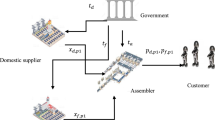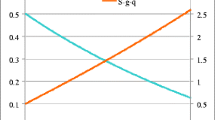Abstract
Nowadays, due to the lack of energy and the harmful effects of fossil fuels on the environment, many countries seek to use renewable sources such as solar energy, a clean and free energy source. Direct conversion of solar energy into electricity is the reason for using solar cells. This paper proposes a three-echelon photovoltaic supply chain with two suppliers (domestic and foreign), two power plants (big and small), and a power distribution system with government intervention. We consider three approaches, including (1) the decentralized model, (2) the centralized model, and (3) the government’s role in the photovoltaic supply chain. In the first model, the power distribution system is a leader, and other members are followers. In the second model, we explore the whole supply chain as a centralized model, and in the third model, the government has the leading role, and the rest of the members follow. Indeed, in the last model, the role of the government as a supporter that gives subsidies and tax exemptions to keep members in a competitive market is investigated, and the decision variables of the government (tariffs) are obtained. Finally, based on real example from the power industry of Iran, sensitivity analysis and managerial insights are proposed.













Similar content being viewed by others
Data Availability
Not applicable.
References
Azapagic A, Emsley A, Hamerton I (2003) Polymers: the environment and sustainable development. John Wiley & Sons
Chatzisideris MD et al (2017) Cost-competitiveness of organic photovoltaics for electricity self-consumption at residential buildings: a comparative study of Denmark and Greece under real market conditions. Appl Energy 208:471–479
Chauhan A, Saini RP (2014) A review on Integrated renewable energy system based power generation for stand-alone applications: configurations, storage options, sizing methodologies and control. Renew Sustain Energy Rev 38:99–120
Chen Z, Cheung KCK, Qi X (2021) ‘Subsidy policies and operational strategies for multiple competing photovoltaic supply chains’. Flexible Services and Manufacturing Journal, pp. 1–42
Chen Z, Su S-II (2014) Photovoltaic supply chain coordination with strategic consumers in China. Renewable Energy 68:236–244. https://doi.org/10.1016/j.renene.2014.01.035
Chen Z, Su S-II (2016) The joint bargaining coordination in a photovoltaic supply chain. Journal of Renewable and Sustainable Energy 8(3):35904
Chen Z, Su S-II (2017) Dual competing photovoltaic supply chains: a social welfare maximization perspective. Int J Environ Res Public Health 14(11):1416
Chen Z, Su S-II (2018) Multiple competing photovoltaic supply chains: modeling, analyses and policies. J Clean Prod 174:1274–1287
Chen Z, Su S-II (2019) Social welfare maximization with the least subsidy: photovoltaic supply chain equilibrium and coordination with fairness concern. Renewable Energy 132:1332–1347
Chen Z, Su S-II (2020) International competition and trade conflict in a dual photovoltaic supply chain system. Renewable Energy 151:816–828
Chen Z, Su S-II (2022) Countervailing effect and mitigation policy: a game-theoretical study in dual international competing photovoltaic supply chains. Renewable Energy 183:160–171
Dehghani E et al (2018a) Resilient solar photovoltaic supply chain network design under business-as-usual and hazard uncertainties. Comput Chem Eng 111:288–310
Dehghani E et al (2020) ‘An environmentally conscious photovoltaic supply chain network design under correlated uncertainty: a case study in Iran’. Journal of Cleaner Production 121434.
Dehghani E, Jabalameli MS, Jabbarzadeh A (2018b) Robust design and optimization of solar photovoltaic supply chain in an uncertain environment. Energy 142:139–156
Gautam A, Shankar R, Vrat P (2021) End-of-life solar photovoltaic e-waste assessment in India: a step towards a circular economy. Sustainable Production and Consumption 26:65–77
Goetzberger, A. and Hoffmann, V. U. (2005) Photovoltaic solar energy generation. Springer Science & Business Media.
Goodarzi S, Aflaki S, Masini A (2019) Optimal feed-in tariff policies: the impact of market structure and technology characteristics. Prod Oper Manag 28(5):1108–1128
Hadi T et al (2020) ‘Pricing strategy for a green supply chain with hybrid production modes under government intervention’. Journal of Cleaner Production 121945.
Hafezalkotob A (2015) Competition of two green and regular supply chains under environmental protection and revenue seeking policies of government. Comput Ind Eng 82:103–114
Hafezalkotob A (2017a) Competition, cooperation, and coopetition of green supply chains under regulations on energy saving levels. Transportation Research Part e: Logistics and Transportation Review 97:228–250
Hafezalkotob A (2017b) Competition of domestic manufacturer and foreign supplier under sustainable development objectives of government. Appl Math Comput 292:294–308
Hafezalkotob A, Alavi A, Makui A (2016) Government financial intervention in green and regular supply chains: multi-level game theory approach. International Journal of Management Science and Engineering Management 11(3):167–177
Jolai H, Hafezalkotob A, Reza-Gharehbagh R (2021) Pricing and greening decisions of competitive forward and reverse supply chains under government financial intervention: Iranian motorcycle industry case study. Comput Ind Eng 157:107329
KharajiManouchehrabadi M, Yaghoubi S (2019) Solar cell supply chain coordination and competition under government intervention. Journal of Renewable and Sustainable Energy 11(2):23701
Kharaji Manouchehrabadi M, Yaghoubi S (2020) ‘A game theoretic incentive model for closed-loop solar cell supply chain by considering government role’. Energy Sources, Part A: Recovery, Utilization, and Environmental Effects 1–25
Liu Y et al (2019) Corporate social responsibility and decision analysis in a supply chain through government subsidy. J Clean Prod 208:436–447
Madani SR, Rasti-Barzoki M (2017) Sustainable supply chain management with pricing, greening and governmental tariffs determining strategies: a game-theoretic approach. Comput Ind Eng 105:287–298
Mahmoudi R, Hafezalkotob A, Makui A (2014) Source selection problem of competitive power plants under government intervention: a game theory approach. Journal of Industrial Engineering International 10(3):59
Mahmoudi R, Rasti-Barzoki M (2018) Sustainable supply chains under government intervention with a real-world case study: an evolutionary game theoretic approach. Comput Ind Eng 116:130–143
Manouchehrabadi MK, Yaghoubi S, Tajik J (2020) Optimal scenarios for solar cell supply chain considering degradation in powerhouses. Renewable Energy 145:1104–1125
Nili M et al (2021) A multi-objective optimization model to sustainable closed-loop solar photovoltaic supply chain network design: a case study in Iran. Renew Sustain Energy Rev 150:111428
Parida B, Iniyan S, Goic R (2011) A review of solar photovoltaic technologies. Renew Sustain Energy Rev 15(3):1625–1636
Sampaio PGV, González MOA (2017) Photovoltaic solar energy: conceptual framework. Renew Sustain Energy Rev 74:590–601
Sheu J-B (2011) Bargaining framework for competitive green supply chains under governmental financial intervention. Transportation Research Part e: Logistics and Transportation Review 47(5):573–592
Sheu J-B, Chen YJ (2012) Impact of government financial intervention on competition among green supply chains. Int J Prod Econ 138(1):201–213
Sinayi M, Rasti-Barzoki M (2018) A game theoretic approach for pricing, greening, and social welfare policies in a supply chain with government intervention. J Clean Prod 196:1443–1458
Xie G (2015) Modeling decision processes of a green supply chain with regulation on energy saving level. Comput Oper Res 54:266–273
Xu T, Ma J (2020) Feed-in tariff or tax-rebate regulation? Dynamic decision model for the solar photovoltaic supply chain. Appl Math Model 89:1106–1123
Yang D, Xiao T (2017) Pricing and green level decisions of a green supply chain with governmental interventions under fuzzy uncertainties. J Clean Prod 149:1174–1187
Yang M, Gong X (2021) ‘Optimal decisions and Pareto improvement for green supply chain considering reciprocity and cost-sharing contract’. Environ Sci Pollut Research 1–16
Yang M, Zhang T, Wang C (2021) The optimal e-commerce sales mode selection and information sharing strategy under demand uncertainty. Comput Ind Eng 162:107718
Zand F, Yaghoubi S, Sadjadi SJ (2019) Impacts of government direct limitation on pricing, greening activities and recycling management in an online to offline closed loop supply chain. J Clean Prod 215:1327–1340
Zhang X, Yousaf HMAU (2020) Green supply chain coordination considering government intervention, green investment, and customer green preferences in the petroleum industry. J Clean Prod 246:118984
Zhang YH, Wang Y (2017) The impact of government incentive on the two competing supply chains under the perspective of corporation social responsibility: a case study of photovoltaic industry. J Clean Prod 154:102–113
Zhao J, Zhang Q (2021) The effect of contract methods on the lead time of a two-level photovoltaic supply chain: revenue-sharing vs. cost-sharing. Energy 231:120930
Author information
Authors and Affiliations
Contributions
Sahar Matinfard: software, validation, investigation, formal analysis, resources, data curation, writing — original draft preparation, writing — reviewing and editing, conceptualization, methodology, and visualization.
Saeed Yaghoubi: conceptualization, methodology, formal analysis, writing — reviewing and editing, visualization, supervision, and project administration.
Maedeh Kharaji Manouchehrabadi: software, writing — original draft preparation, data curation, methodology, formal analysis, writing — reviewing and editing.
Corresponding author
Ethics declarations
Ethics approval and consent to participate
Not applicable
Consent for publication
Not applicable
Competing interests
The authors declare no competing interests.
Additional information
Responsible Editor: Philippe Garrigues
Publisher's note
Springer Nature remains neutral with regard to jurisdictional claims in published maps and institutional affiliations.
Appendices
Appendix 1. Model 3.1
The amount of decentralized (Stackelberg leader–follower game) decision variables is shown in this part:
Appendix 2. Model 3.2
The amount of centralized decision variables is shown in this fragment:
Rights and permissions
About this article
Cite this article
Matinfard, S., Yaghoubi, S. & Kharaji Manouchehrabadi, M. Impact of government policies on photovoltaic supply chain considering quality in the power distribution system: a case study. Environ Sci Pollut Res 29, 58810–58827 (2022). https://doi.org/10.1007/s11356-022-19884-7
Received:
Accepted:
Published:
Issue Date:
DOI: https://doi.org/10.1007/s11356-022-19884-7




